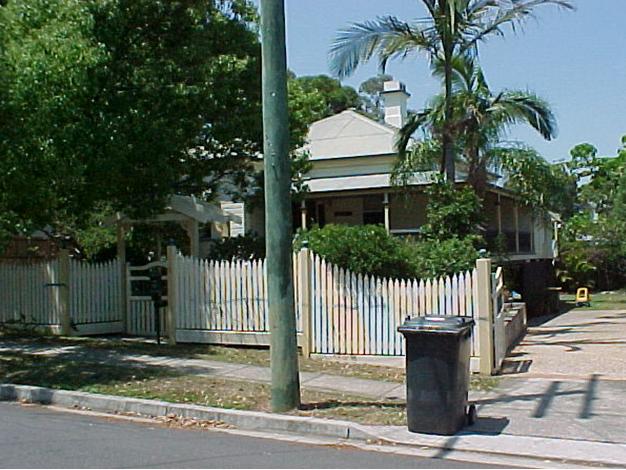Addresses
Type of place
House
Period
Victorian 1860-1890
Style
Queenslander
Addresses
Type of place
House
Period
Victorian 1860-1890
Style
Queenslander
“Witherby” is a 19th century house, built on a large allotment in Wooloowin during the building boom of the 1880s. As one of the earlier houses built here, it is part of the history of the development of Wooloowin as an inner-city suburb for families and is a good representative of the movement of middle civil servants into Brisbane’s suburbs, attracted by the completion of the rail line.
Lot plan
L80_RP19404; L81_RP19404
Key dates
Local Heritage Place Since —
Date of Citation —
Construction
Roof: Corrugated iron;Walls: Timber
Criterion for listing
(A) Historical; (B) RarityInteractive mapping
Lot plan
L80_RP19404; L81_RP19404
Key dates
Local Heritage Place Since —
Date of Citation —
Construction
Roof: Corrugated iron;Walls: Timber
Criterion for listing
(A) Historical; (B) RarityInteractive mapping
History
The land on which this house is situated was part of over fifty acres originally purchased by brothers Aaron and John Adsett in the land sales of 1858-9. In 1866 John Adsett acquired title to a twenty-five acre portion, holding it for many years before selling it to John Lloyd Bale in August 1883. Bale engaged surveyors Hamilton & Raff to subdivide the land into 197 lots (virtually all sixteen perches except for nine smaller lots). These were marketed by auctioneers E. Hooker & Son as Maida Hill Estate, from December 1884 onwards.
The successful completion of the Ipswich-Brisbane rail line in 1876 had encouraged those desiring a rail link to Sandgate to press their claims. After consideration of several alternative routes, the Government in 1880 approved a line running from Roma Street, through Albion, and northwards and eastwards to terminate at Sandgate. The contract was let to George Bashford & Co, the line formally opened on 10 May 1882. Regular services began the next day.
When the line first opened, stations were constructed at Lutwyche (later renamed Wooloowin, and moved north by 140 metres in 1900), Thorroldtown (inserted in 1885 600 metres north of Lutwyche), and Eagle Junction. The 1882 Lutwyche Station was regarded as being at the fringes of suburban development, but development was proceeding quickly, as indicated by the 1885 construction of Thorroldtown Station as a part of a private land development. Thorroldtown closed in 1890, after only five years.
In August 1886 bootmaker William Rowe bought four adjoining lots in the Maida Hill Estate, two on Rigby Street and two on Fraser Street. Rowe sold the Rigby Street lots a year later, and at about the same time, built a cottage on the Fraser Street frontage. It is probable that Rowe’s sale of the Rigby Street land financed the construction of his small house.
The purchaser of the two Rigby Street lots was Edward Thomas Trundle, an accountant in the Education Department. Trundle is listed in the Queensland Post Office Directory of 1890 as living at “Lutwyche”, as this part of Maida Hill had come to be named. It is probable that Trundle, and wife Charlotte Elizabeth to whom he transferred the property in January 1889, built their house immediately after purchasing the land from Rowe.
The Trundles were one of the earlier residents in Rigby Street. Even by 1893 they had only one neighbour on either side of them – commercial traveller W.H. Wright on the eastern side in “Tresyllian”, and accountant and paymaster G.H. Parminter some distance to the west in “Lizmar”. These three houses were quite large – the houses of successful public servants and businessmen, each on multiple lots. Later houses began to fill the gaps, but were more modest affairs, mostly each on an original single sixteen perch lot.
In December 1917 Charlotte transferred the property to their unmarried daughter Eleanor Gertrude, who held it for another three decades. In total the Trundle family owned the property for the first sixty years of its existence.
Statement of significance
Relevant assessment criteria
This is a place of local heritage significance and meets one or more of the local heritage criteria under the Heritage planning scheme policy of the Brisbane City Plan 2014. It is significant because:
References
-
Brisbane City Council Metropolitan Water Supply and Sewerage Board, Detail Plans
-
Department of Natural Resources, Certificates of Title
-
Kerr, J 1988, Brunswick Street, Bowen Hills and Beyond: the Railways of the Northern suburbs of Brisbane, Australian Railway Historical Society, Brisbane
-
John Oxley Library photographs & clippings files
-
Lawson, Ronald 1973, Brisbane in the 1890s: A Study of an Australian Urban Society, University of Queensland Press, St. Lucia
-
McKellar’s Estate Maps of Brisbane, 1895
-
Queensland Pioneers Index 1829-1889, Qld Registrar-General, March 2000
-
Queensland Post Office Directories, 1887-1949
-
Windsor & Districts Historical Society 2000, A Walk Through the History of Thorroldtown and Maida Hill
Citation prepared by — Brisbane City Council (page revised June 2022)

